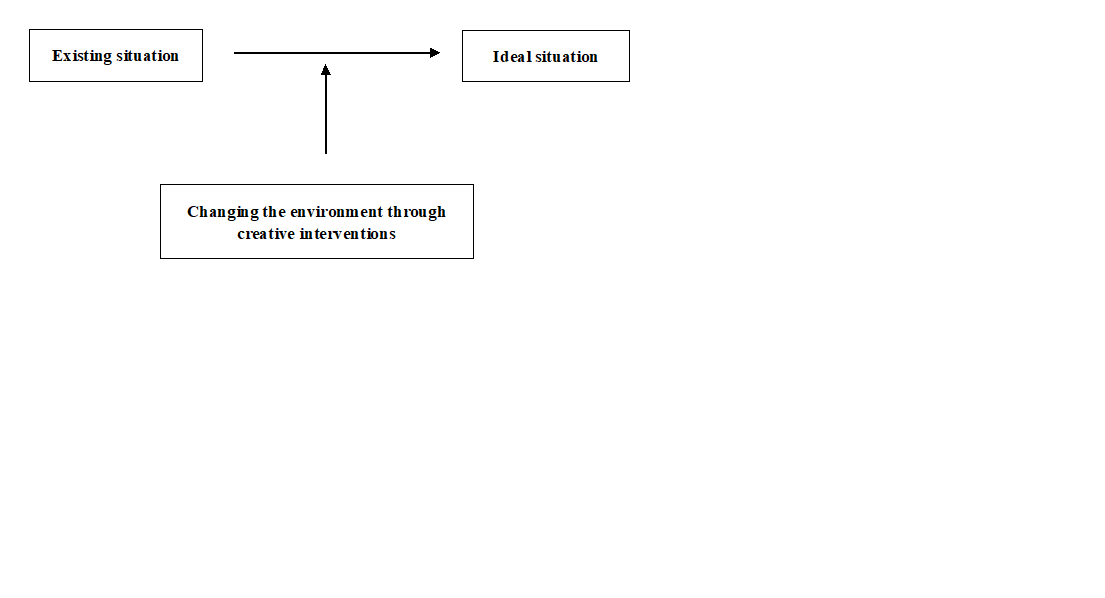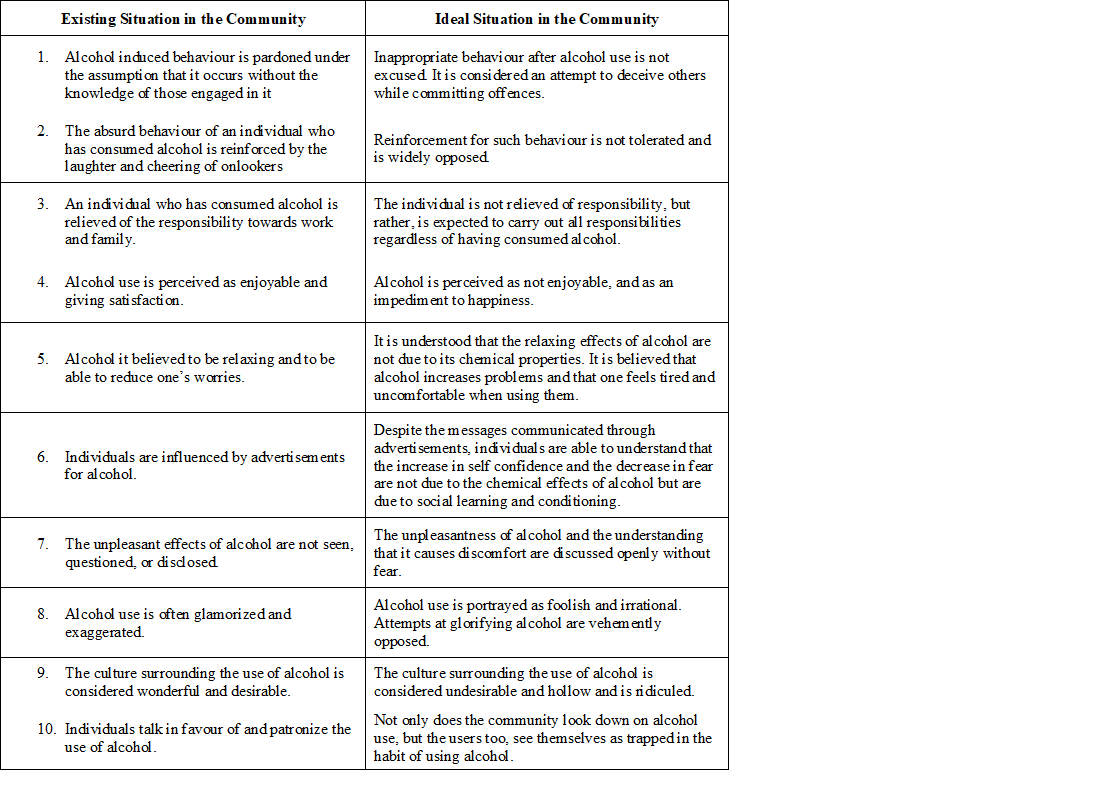Changes Expected within the Community.
The ultimate expectation of prevention efforts is to create an environment in which non-users are not induced to initiate the use of alcohol and alcohol users are inspired to reduce or discontinue the use. In order to achieve this expectation, the community as a whole must refrain from glamorizing and mystifying alcohol and the related experiences. Steps could also be taken by members of the community to reverse the existing positive image and high status attributed to alcohol as a result of the users’ false glorification of their experiences of using it.
This approach could be implemented by identifying the rituals and symbols that give value to alcohol use and changing the social influences through creative and innovative activities. In the resulting changed environment alcohol use would eventually lose its aura of power, enjoyment, and relaxation and come to be viewed as tasteless and unglamorous. The experience of using alcohol and drugs would be limited to their chemical effects which, as proven through laboratory studies, are rather unexciting and unpleasant.
In an environment in which alcohol is not glorified and glamorized, even those who have used alcohol and other substances over a prolonged period of time would begin to recognize the difference between its learned pleasant effects and its actual unpleasant chemical effects. Those who are particularly dependent on alcohol may also begin to realize that the positive feelings they experience when using alcohol are mainly due to the relief from withdrawal discomfort.
As the community grows to be increasingly enlightened, it will be possible to observe a gradual decrease in the sense of enchantment and wonder attached to alcohol use. The symbolic meanings attached to alcohol will also begin to decline in importance. The changes in the community can be catalogued as follows:
- People, especially non – users, begin to see the consumption of alcohol in a new light. They cease to assume that alcohol use is a highly pleasurable experience and that it helps individuals to forget their worries and relax. While users are looked at with sympathy for the restrictions that alcohol use imposes on their lives, they are not given special privileges to break social norms but rather, are held accountable for their behaviour and misbehaviour while under the influence of alcohol.
- On examining their experience with alcohol, occasional alcohol users begin to discover that what they experience due to the chemical effects of the substance is not pleasant. They eventually come to realize the ways in which the “culture” built around alcohol has become the main contributing factor to the joy experienced when consuming it. Users find that the glamour of using alcohol has diminished as the community no longer views alcohol use as special and sees them (the users) as victims. They also discover that the community does not encourage them to victimize and molest others under the guise of intoxication and that they are held to task for their actions just as they would be had they been sober.
- Regular or daily users of alcohol begin to understand that alcohol use is only pleasurable to the extent that it reduces the discomfort that they experience when they do not consume it. They admit to others too that they are driven to use alcohol because of these withdrawal symptoms and not because of any pleasurable experiences produced by alcohol.
- Both, users and non-users work to prevent the spread of alcohol use, and recognize the losses that the community incurs as a result of the use of alcohol. Both groups do not see alcohol prevention as a battle between users and non-users. Instead, the entire community unites in challenging the statements, expressions, practices, and rituals which invest alcohol use with a special aura.
- An environment is created in which any individual who uses alcohol finds the experience to be unattractive and unpleasant.
Action taken in alcohol prevention can be summarized as follows.
- Understanding the existing situation.
- Understanding the ideal situation
- Changing the environment towards the ideal situation through creative interventions.
Fig. 4: Changing the Existing Situation in the Community through Creative Activities
Table 3: Expected Situation Change in the Community
Initiating Public Discussion
Following the formation of the CAT and assessing the need for alcohol prevention, the next step in the community level prevention programme is to reach out to create an accurate understanding on alcohol among the wider public. This could be achieved through a public discussion on the changes required to reduce and prevent the use of alcohol and other drugs within the community. Awareness could also be created by using the existing channels of day to day communication. In spreading knowledge among the members of the community, it is very important to get the participation of community leaders, government officials, representatives from voluntary organizations, and as many individuals as possible from the various sectors of the general public for a formal discussion. The venue could be a school, place of worship, a community centre, or a home.
The participation of the general public as well as voluntary organizations, representatives from the clergy, sports organizations, and youth clubs could be achieved by displaying notices or posters in prominent locations within the community. It is also important that alcohol users are represented at this meeting.
Preparation
This book could be used as one of the main resource materials in planning the programme and guiding the course of the discussion at the initial meeting and at other subsequent gatherings. The following are useful steps that could be taken in preparing for the initial meeting in the community.
- Ensure that all the items necessary for the discussion are available
- Notify potentially valuable resource persons who could contribute to the programme well in advance. It might be useful to give them a second reminder closer to the set date of the meeting
- Prepare an outline of responsibilities that should be delegated after the discussion
- A designated person could facilitate discussion (the person could be selected with the help of the points outlined in the next section)
- The person conducting the discussion should thoroughly study the available subject matter relevant to the discussion (as per the points given in the next section on the agenda of the meeting)
- Prepare a black board and chalk, a white board and markers, or some other means of presenting the points discussed in writing
- Have ready a pen and a paper to note down decisions and salient details arising from the discussion
Agenda
A tentative agenda for the meeting is shown below.
- Welcome address and explanation of the reason for the meeting
- An explanation on the need for alcohol prevention
- The recommendation of new methods
- Discussion/brainstorming session
- Planning a strategy and delegating responsibilities among members of the CAT and others presen
Conducting the Discussion
At the very outset of the discussion, participants should be made to understand the nature of the meeting, that it would not be a lecture but an open forum at which they are required to air their opinions and views in order to reach a consensus. The participants would then be given examples of substances that are in common use including the traditional alcoholic beverages. It must be made clear that though there are a diverse variety of addictive substances, only the most commonly used substances, in this case alcohol, will be discussed.
The calculation of the approximate expenditure on alcohol within the community during a day, month, and year must be demonstrated at the discussion. If resources are available for a survey in this regard based on a sample from the community, such a survey could be conducted prior to the meeting and a visual image of the situation in the community, including the relevant statistics, could be presented at the meeting using tables and graphs. The audience could then be asked to present their suggestions on how the money otherwise spent on alcohol could be used instead for development work in the community or for genuine pleasure and entertainment.
A Few Points for Discussion
- Participants should be made aware of the primary target for prevention interventions, namely the children and youth in the community, as it is these groups that are at the highest risk of taking up the use of alcohol in the future.
- Challenges for the community should be set. The greatest of these is to prevent people from initiating the use of alcohol.
- A consensus must be reached on what activities are to be conducted through the prevention strategy.
During the meeting, it should be explained that users of alcohol are often aware of the harm they pose to the community by engaging in the use of this substance. Participants should be made aware of the primary effects of alcohol use, for example, the large number of deaths directly linked to alcohol use. They should also be made aware, of its secondary effects such as the problems faced by the families of users as a result of the high expenditure on alcohol.
The question of why people continue to use alcohol despite the knowledge of the potential economic, social, and health problems that could occur as a result should be raised and discussed. Responses to the question below should be elicited from the participants.
- What are the common reasons given for alcohol use?
The responses received could be noted on a black/white board. Responses are likely to include the following points and if not, participants could be presented with the points following the gathering of responses to the above question.
- A means of forgetting problems
- A symbol of being “macho” or daring
- A means of fun and enjoyment
- A means of easing weariness
- A means of enhancing creativity
- A means of warmth
- An appetizer
- A symbol of sophistication
Each of these points should be examined in detail as follows.
A Means of Forgetting Problems
Though some resort to drinking alcohol in order to escape the realities of life or forget their troubles, in reality, their problems do not cease to exist. Rather, the more alcohol is consumed, the worse the problems become. People may recount old problems when intoxicated, thereby becoming more depressed and anxious as their problems increase. For example a man who may not hold grudges against his peers when sober may, while intoxicated, remember and dwell on past disagreements with his peers and any harm they may have done him. This would lead him to develop strong negative emotions which he may act on by seeking out and attacking those involved in the disagreements or other harmful acts. This shows that the ability to remember or forget problems is not necessarily an effect of alcohol but rather, it is a result of learned expectancies.
The participants at the meeting should be made to understand that despite existing evidence to the contrary, the belief that alcohol enables one to forget one’s problems prevails in society. This belief can become further reinforced either advertently or inadvertently through certain actions. For example, parents may comment in the presence of their children that certain people drink alcohol because they face problems. Similarly, TV programmes and novels occasionally portray characters with worries that drink alcohol as a means of achieving relief. This creates an idea among non-users including children, that alcohol helps people to forget their worries. When such beliefs are expressed, they must be questioned and corrected immediately so as to prevent young people and children from acquiring baseless notions concerning potentially harmful substances.
A Means of Being “Macho” or Daring
Alcohol induced behaviour is often used as a means of showing off and those engaged in it are usually well aware their own actions. At the discussion, the participants can be asked about the behaviour of a person following a bout of drinking and how it changes in the midst of various others, for instance, how the person would behave before those of a similar or lower state of strength and power and before those greater in strength and power such as a police officer. Typically, in the presence of the latter, alcohol users are likely to turn weak and cringe despite the same amount of alcohol being present in their systems as in instances where they would behave aggressively in the presence of the former. Individuals that thrive on this false sense of courage do not usually choose tougher targets for their assaults. From this, it is possible to understand that alcohol induced behaviour is directed at those who are weak and defenseless or who always tolerate and pardon such behaviour seeing alcohol as responsible for the actions of the users. For example, when an alcohol user beats his wife under the influence of alcohol, he is well aware that he will not be held accountable the next day.
The state of disinhibition reported by alcohol users is not so much a chemical effect of alcohol as it is an effect of expectancies based on social milieu. In other words people, who consume alcohol and claim to misbehave due to its effects, actually act more on what they have learned from society than on any natural effects of alcohol. Yet, as alcohol induced misbehaviour is pardoned or viewed with tolerance and permissiveness and in many societies there is a tendency to blame the alcohol and not the user for aggressive behaviour. Hence, alcohol is used as an alibi or an excuse for unacceptable behaviour. As a result, alcohol users, following a session of drinking and inappropriate or aggressive behaviour, may often use statements such as the following to justify their actions:
- “I had too much………..”
- “I was under the influence……..”
- “I can’t remember………”
It may be observed that in societies where there is little tolerance and pardoning of alcohol use, alcohol users are less likely to behave abusively.
A Means of Fun and Enjoyment
While the use of alcohol is commonly associated with pleasant emotions and sensations, the factual basis for this belief requires close examination. At the meeting, participants could be requested to consider the occasions on which people are most likely to use or be enticed to use alcohol. In response, participants may present occasions such as parties, the celebration of festivals, meetings with peers at the end of examinations, trips, and special holidays, all of which share certain common features, for example:
- They are all characterized by a prevailing sense of happiness and joy
- They all involve a friendly gathering of people
- Their overall atmosphere is relaxed
It is worth noting that as alcohol is usually consumed on occasions that are already characterized with happiness and a sense of freedom from responsibility, it is possible that over a period of time the presence of alcohol would easily be assumed to be the cause of the feeling of happiness, freedom, and relaxation. Alcohol would eventually come to be used on special occasions based on the belief that such occasions become enjoyable only as a result of the alcohol consumed. The reality however, is that when alcohol is used on special occasions over an extended period, users begin to believe that the enjoyment they experience on such occasions is created by the alcohol. Hence, they gradually begin to associate feelings such as pleasure with alcohol use. The act of using alcohol then acquires the image of being fun-filled and pleasurable.
If people were to experiment with alcohol in settings devoid of the relaxed, happy atmosphere typically seen at a social gathering, their experiences would be very different in that they would be more likely to experience discomfort. Users leaving the company of their group of fellow alcohol users, when asked, may report feeling severe discomfort once they are alone. At this point, people may recognize the effects of alcohol as being those of physical and mental discomfort. Nevertheless, when one gets accustomed to taking alcohol, one learns to tolerate the discomfort and suffering and becomes conditioned to link alcohol with pleasure. It is also true that a person who uses alcohol is required to pretend that the experience is pleasurable despite the fact that he/she actually experiences nausea, dizziness, thirst and lack of co-ordination.
The effects of alcohol may not be felt when it is taken in small quantities. However, as one imbibes it, expectations may be activated so that, a person may feel pleasure and not experience any of its chemical effects. The actual effects of alcohol are dizziness, lack of coordination, stilted speech, nausea and thirst which if experienced without having consumed alcohol, would drive people to seek medical attention. However, when the same symptoms occur following alcohol use, they are more likely to hide them and pretend to experience pleasure. Therefore, in order to experience the actual chemical effects of alcohol, such people must consume a large quantity of the substance. An important part of the prevention strategy is then to guide people to see the actual effects of alcohol before they become conditioned to perceive it as a form of enjoyment.
A Means of Easing Weariness
People sometimes drink alcohol after a day of hard work believing that it would ease their fatigue. Those who engage in demanding jobs are often in the habit of taking a break for a quick drink at a nearby bar and may eventually come to believe that it is the alcohol they consume during this break that relieves their physical and mental fatigue. Those who use alcohol in this way should be made to understand that the ensuing feeling of relaxation is due to the break in the strain or monotony of the job and is not due to the alcohol. The same rationale is true in the case of the school interval and the intermissions at a theatre or cinema.
Alcohol may is also used as a means of celebration at the completion of a task, especially perhaps, one that is particularly challenging. Though there is naturally a sense of achievement and self-satisfaction on the completion of a task, a person accustomed to using alcohol on completing a job begins to attribute the sense of satisfaction and fulfillment to alcohol so that it is the alcohol that eventually becomes symbolic of relaxation. This is also true for acts such as drinking a hot cup of tea or changing from the clothes worn to work to the more comfortable attire worn at home on returning home from the workplace, both of which could become symbols of relaxation to those who engage in them regularly. Alcohol use at the end of a day’s work is then no different from other habits that non-users engage in for similar reasons.
A Means of Enhancing Creativity
Some artists and craftsmen in the habit of using alcohol claim that it enhances their creativity. Though creativity is an inborn quality, as a result of developing the habit of using alcohol before embarking on an artistic project could over a certain period, result in artists and craftsmen beginning to regard alcohol as a mechanism that triggers creativity.
Artists and craftsmen who use alcohol with this belief could be challenged with the question as to whether it would be possible for a student, who once lacked ideas in order to complete a particular project assigned to him/her at school (such as an essay), to suddenly be able to develop ideas if alcohol is given to him/her.
A Means of Warmth
Some use alcohol as a means of warmth in cold weather, claiming that they feel warmer following a few drinks. What happens in reality is that alcohol causes the veins and arteries to expand and move closer to the surface of the skin, the same phenomenon that occurs when engaging in strenuous physical exercises that causes the flushed complexion seen especially in those with lighter complexions. This process causes the body to emit heat so though people may temporarily feel warm immediately after consuming alcohol, they are actually losing body heat and once the effects of the alcohol have worn off they may eventually colder than they had before using alcohol.
An Appetizer
Alcohol is often viewed as a substance that enhances appetite. Some may believe that alcohol enables them to eat normally or better than they would otherwise be able to and others may use it simply as an appetizer. People in the habit of consuming alcohol before or with meals may feel uncomfortable without it. These are yet more examples of the ways in which the alleged positive effects of alcohol are generated. By making participants at the discussion aware of situations such as these that they may encounter on a day to day basis, it is possible to create awareness on the opportunities for alcohol prevention.
Interventions at Community Level
Through community level interventions, it is necessary to ensure that members of the community understand the basis of the presumed pleasure in alcohol use. The community must be made aware that alcohol aggravates, rather than facilitates the forgetting of problems. They must also be made to understand that any form of drunken behaviour is carried out under complete volition. Further, the community must be made aware that the social acceptance of alcohol induced misbehaviour is due to existing social beliefs and not otherwise and that the basis of these beliefs is the assumption that alcohol inhibits the cognitive process and the ability to reason thereby magically transforming users into beasts. The community should be guided to challenge statements such as “I was under the influence of alcohol…. I can’t remember a thing…” commonly used as an excuse for alcohol induced misbehaviour and not to pardon such behaviour.
Community level interventions should also seek to rebut words and phrases connected to alcohol use such as “as high as a kite”, “smashed”, “one for the road”, “drink one”, “under the taboo”, “cheers”, “bottoms up” etc, all of which attribute connotations of fun and pleasure or strength and vitality when referring to alcohol. These words should be shown as a means of hiding the actual unpleasant experiences of alcohol use. Similarly, the rituals and practices surrounding the use of alcohol must also be revealed to be a façade used as a means of concealing its unpleasantness. This could be done by asking alcohol users to express their actual experiences of consuming alcohol via individual interviews.
Interventions should seek to guide the community to view alcohol use as a sign of weak character and low self esteem and to expose the use of these substances for what it actually is (i.e. an unpleasant experience hidden by pleasant factors that form its setting and atmosphere). The community should be educated on identifying symbols that contribute to the positive image of alcohol, for example, sporting gear bearing logos and slogans that promote particular brands of alcoholic beverages that in actuality demean the sport.
The community should also be educated on the subtle signs of alcohol promotions that are displayed even within the home such as empty liquor bottles and wine glasses that are displayed as ornaments and gift items of alcoholic beverages that are displayed as souvenirs. Similarly, awareness should be spread on the many jokes, yarns, and amusing stories that either focus on or include alcohol, depicting them in a positive manner. It must be made known that by deriving amusement from such jokes, yarns, and stories or be relating them to entertain others people inadvertently promote the use of alcohol and make it more socially acceptable. The message could be spread that by not being amused by stories and jokes that promote alcohol, one could support prevention efforts by refraining from flaunting the use of alcohol.
Prevention activities could also involve showing alcohol use to be a violation of the rights of non-users. Taking tobacco use for example, non-smokers have a right to live in a smoke free environment and smoking in public places, being an inconvenience as well as a health hazard, is a violation of that right. A similar scenario could be drawn up for alcohol, for instance, the people could be made to understand that alcohol users violate the rights of non-users by depriving them of an environment free from the odor of alcohol and the related violent and abusive behaviour. The actual effects of alcohol, or the ways in which it impairs the well being of the users, should also be exposed particularly in the sense that by impairing their well being, users are depriving themselves of their rights. This could be done using as examples, the various myths that glorify alcohol despite its actual negative effects. For example, though alcohol is served at parties in order to increase the level of enjoyment, what happens in reality is that alcohol decreases the pleasure of those who consume it so that they are unable to enjoy themselves as much as they would have otherwise been able to. This is due to symptoms such as dizziness, nausea, thirst, and the lack of coordination resulting from alcohol. Similarly, while alcohol tends to be viewed as a means of relaxation, as the removal of the toxic metabolites found in alcohol from the body requires the increased functioning of the internal organs so that alcohol users experience increased fatigue and stress. These could be used to show users that by consuming alcohol could they are depriving themselves of their health and wellbeing.
Creating awareness on the high expenditure on alcohol is another effective approach in conducting alcohol prevention activities at community level. A significant amount of wealth is spent on these substances even in small communities, the total cost borne by families, especially among the poorest, often exceeding the amount spent on essential goods. The youth of the community could be gathered and made to calculate a rough estimate or a close approximation of the total expenditure on alcohol within a given period of time. The amount calculated and the ways in which the amount spent on alcohol could otherwise be spent on development could then be discussed with the community leaders. The total cost of alcohol could then be compared with the total amount of the financial aid allocated by the governments towards providing assistance to the marginal groups of society such as Samurdhi beneficiaries. Discussions on the wasteful expenditure on alcohol can also be discussed with the owners of the local shops whose assistance can be sought in the prevention of the use of these substances, especially among underage persons, for example, by taking it as a social responsibility to refrain from displaying the promotional materials of the alcohol companies.
In addition to the above strategies the following messages that depict the emptiness of alcohol use could be displayed within the communities.
- Alcohol snatches away our happiness.
- Yuck! It’s beer!
- Drink if you must, but would you dare to admit that it is unpleasant?
- Don’t be fooled by the myths of alcohol.
- Alcohol is unpleasant.
- Alcohol kills true sportsmanship.
- Really though guys don’t need beer! Beer only makes life bitter!
- Wow! You’re a non-drinker!
- Booze: Not a problem, just a pain!
- Girls hate drunks!
- No alcohol, no fools.
- I love non-drinkers.
- Don’t let alcohol spoil the rhythm of the dance.
- Alcohol and sports do not mix.
- See your youth slip away faster with alcohol.
Dealing with Promoters
It is inevitable that any efforts made towards prevention will meet with opposition from the users and promoters of alcohol. Both groups can and will make attempts to undermine prevention activities, through subtle means if not through direct confrontation. In such instances, the opposition of the alcohol users and promoters could be neutralized through education by involving them in the awareness campaigns conducted within the community. It should be expected that certain users, well entrenched in the use of alcohol, would attempt to disrupt prevention activities with derogatory remarks. Hence, it should be emphasized at the very outset of the initial discussion that prevention activities are by no means a battle between users and non-users, but rather, that alcohol use is an epidemic that harms both parties alike. At this discussion it is also necessary to illustrate that users have unwittingly become agents of the alcohol trade.
Delegation of Tasks
Following the discussion of the above points, participants could be divided into groups and a specific task could be assigned to each group. Campaign leaders should then be identified and target dates should be set for the completion of their assigned tasks. This will form a very useful and solid base for the future initiatives of the CAT. While it is important that all participants take on at least a small task, the tasks undertaken should depend on the interest and level of commitment of each individual.
The overall objective of the programme is to decrease the attractiveness of the image of alcohol within the community. Participants should be free to propose and take on any activity, keeping with this objective, which they are able to conduct independently. For example, a person in the habit of using alcohol at social events can agree to monitor the actual feelings he/she experiences following the use of alcohol. The same person could also leave his/her companions, with whom he/she usually consumes alcohol, for a short while and examine their reactions following the consumption of the drinks to assess as to whether the sensations produced by it are pleasant or unpleasant.
The more active among the participants at the initial discussion could voluntarily take on more responsible tasks. Some of them could undertake educating a given number of people by holding casual discussions through informal contacts, and preferably in informal settings, on the ways in which alcohol is promoted in everyday life, for example, in the way that it is spoken of. Through these casual discussions, volunteers could also make attempts at reversing the social influences promoting alcohol use. Other groups could catalog or assess the losses incurred by the users upon themselves and their families as well as their communities through the use of alcohol. The group of volunteers could spread awareness on this matter among as many members of the community as possible suggesting that steps must be taken at least to minimize if not completely eradicate these losses.
Another possible community level approach is to use relevant activities involving the members of the community to assess the existing positive beliefs about alcohol and to assess any changes in these beliefs, or simply to guide them towards re-examining their own beliefs. Some of the main items discussed earlier in this chapter as points for a public discussion should be useful in conducting these activities. The young people in the community could be mobilized and stimulated to take on an active role in challenging the social image of fun and enjoyment surrounding alcohol. They could be guided to study the words and rituals used by users and non-users that contribute to building a positive image of alcohol following which they could work out ways of challenging and changing this positive image. Finally, the most interested persons could take on the task of approaching special groups and situations and working with them to achieve positive changes. Chapter 7 on “Working with Youth” gives a basic outline on how this could be done. The core group should arrange to meet regularly, for instance on a weekly basis, to review the results of the initial meeting and make plans to reach those volunteers who undertook different tasks at the initial discussion.
Establishing Groups and Subgroups
Prevention efforts by members of the community involve a collective effort by various groups and subgroups formed from among individuals within the community itself. These groups are formed based on what are considered the groups that are most likely to be influenced by factors that promote alcohol use and that have the potential to create a significant difference in the use of alcohol within the community, namely the:
- Youth Women
- Children Users
Shakya Nanayakkara
Secretary General, Healthy Lanka
+94 773786788
shakya@healthylanka.lk










